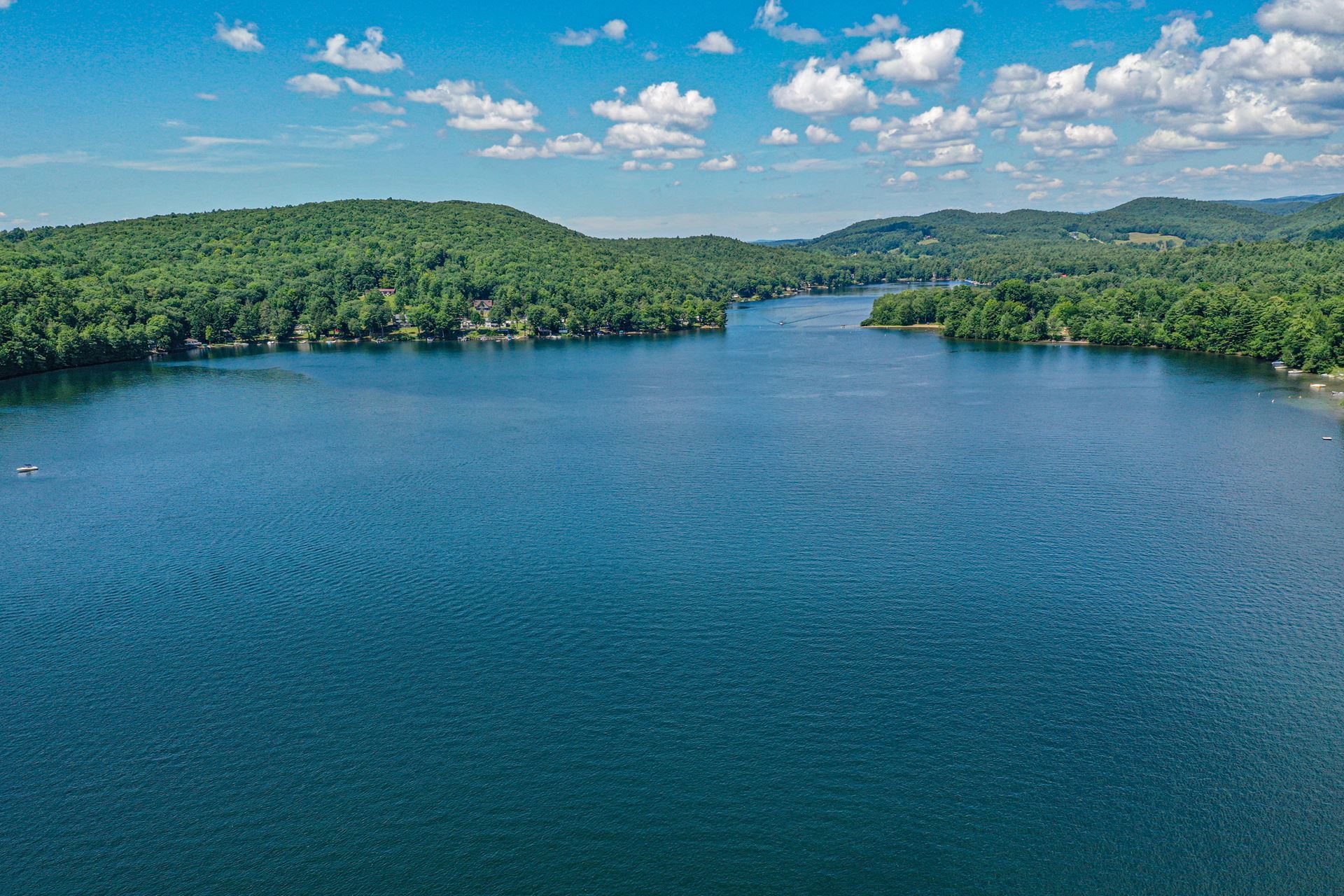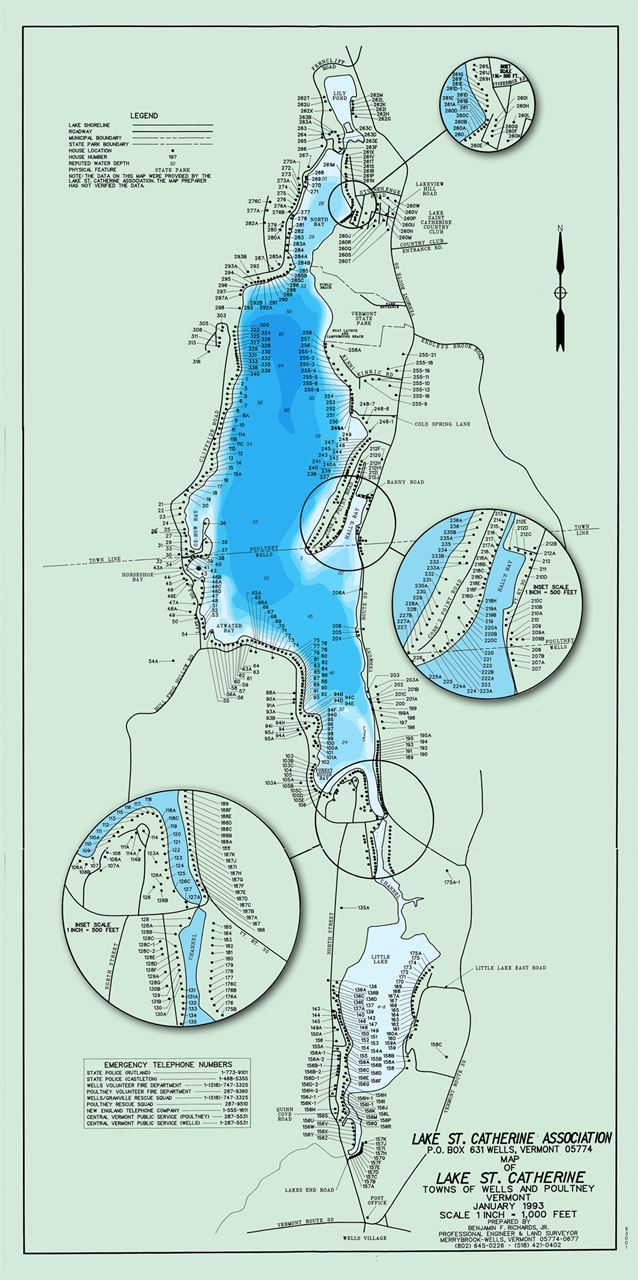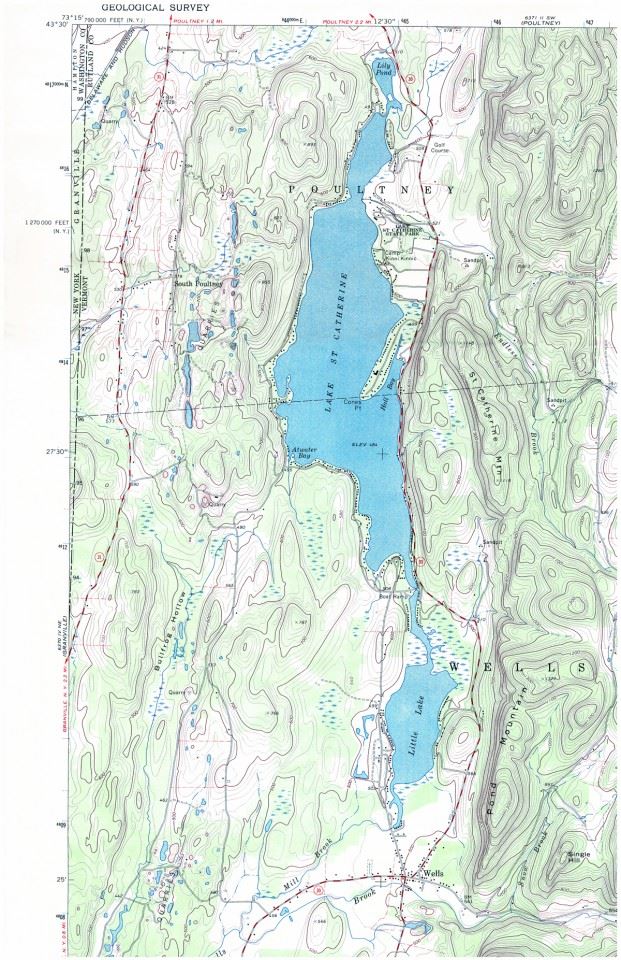For the preservation, protection, and maintenance of Lake St. Catherine |
 |
Lake St. Catherine: History & Maps
HISTORY
Lake St. Catherine is located on the western border of Vermont. It is approximately 29 miles north of Manchester and 26 miles west of Rutland. It lies between the Towns of Poultney and Wells. It has approximately 700 dwellings bordering the lake. It is really a system of three lakes connected by short channels. To the north is Lily Pond, then the Big Lake and to the south, Little Lake. At the southern end of the Big Lake, a bridge crosses the channel to Little Lake allowing easy access to the western shore of the Big Lake. It has free public access to fishing and access to swimming can be had at the State Park off route 30.

From "A Natural Resource Planning Study of Wells, Vermont" Prepared by Raymond Lobdell, February, 1975.
Lake St. Catherine is a large, long lake of 930 acres which begins at the Lily Pond in Poultney and drains south into Wells. The lake has a maximum depth of 68 feet, an average depth of 32.2 feet, and a volume of 29,945 acre feet. It is about five miles long and drains into a narrow channel which connects it with Little Pond.
Little Pond is a shallow lake of about 181 acres, with an average depth of two feet, a maximum depth of only four feet and a volume of 362 acre feet. The lake bottom is covered by a thick layer of silt and organic matter.
From "Lake St. Catherine: A Historical Scrapbook" Complied by Iris Hopson Read Copyright: 1979
No one knows for sure how Lake St. Catherine got its name. To the early settlers the waters were simply Wells Pond or Lake Austin, also a term of uncertain origin but thought to have come from a family by that name at the North End. In Thompson's Vermont Gazetter, the lake is called St. Augustine and at least on one old map so designates it, while others, including Mitchell's Universal Atlas of 1854, give "Lake Austin". Some people think that the more familiar "Austin" is a contraction of Augustine.
In 1869, Hiland Paul, the local historian, wrote "We are of the opinion that the name St. Catherine as applied to this lake is of New York origin, as the oldest inhabitants of the town, who are over eighty years of age, do not remember of hearing it called otherwise than Lake Austin or Lake St. Austin."
In her book Vermont Place Names, Esther Swift says that in 1771 New York patented a town named St. Catherine, in nostalgic remembrance of St. Catherin's Point on the Isle of Wight, the last land seen by the British emigrants as they left England. She adds that when the Green Mountain Boys ran the Yorkers out, they kept the pleasant-sounding name for the lake.
There are other stories and legends but the accepted belief, locally, at least, is that "St. Catherine" was so called by the Jesuits, who came, perhaps before the eighteenth century, carrying on their daring missionary work with the Indians. There is one story which says that two Jesuit priests arrived at the lake on November 25, St. Catherine's Day, and for that reason bestowed her name upon the waters.
The first known written record of "St. Catherine" is on a survey map which was registered in Albany, New York, in 1767. This document grants 5000 acres of land "in the County of Albany... on the west side of a lake called St. Catherine's" to one Col. Maunsell. Of course, all such New York claims were invalidated as Vermont history developed.
Most of the inlets and points around the lake are still known by the name of the one who first settled nearby - - Atwater's Bay, Hall's Bay, Cone's Point, etc. Obviously Ox Bow and Horseshoe Bays were so called because of their shape. The inlet commonly called Forest House Bay (though the term has little significance at present) was originally Bowe's Bay, for Amos Bowe, an outstanding man of the early era. He was the great grandfather of Mrs. Philip Connell who, with her husband, now owns cottage No. 7. It is interesting to note that the land surrounding this inlet, at present a popular bathing beach, was mentioned in an early Wells history as a prosperous farm.
The dam at the outlet of the lake has been an important factor in the St. Catherine story through the years for it has regulated the depth of the water and has made possible various industries. The Wells Historical Society has in its possession a petition (called a "memorial") of one Joseph Lamb, believed to have been written about 1800, asking the town to grant him permission to build a dam. This document, still beautifully legible, reads in part as follows:
"Being situate on the stream at the outlet of the Great Pond in sd. Wells where your memorialist hath a larg Quanity of good white Pine, oak and other valuable timber for Boards, Planks and other Materials for Building... wherefore a good sawmill Erected on the stream aforesd. must greatly to the advantage and utility of the inhabitants of the town in genral as well as to your memorialist in perticular… would humbly pray that he may have the liberty to build a dam to raise the water of sd. pond only thirty-seven inches."
We do not know if this "memorial" was granted but it seems that soon after 1800 the first dam was built and it made possible not only a sawmill but many other small industries. One of these, also at the outlet but at a somewhat later date, was a wagon shop which did business for many years. On the stream which flows out of the lake, known as Mill Brook or Pond Brook, there were several businesses, including a wood working shop which made coffins and other articles. There were three successive woolen mills, all on the same site, the first built in 1795. The third and last, the famous Lake Austin Knitting Mill, was one of the largest manufacturing establishments in the entire area in the late eighteen hundreds. There was also a tannery, a cheese factory and a grist mill. The latter, built in 1808, is still standing. Today one seldom thinks of Lake St. Catherine as a source of energy but throughout much of the nineteenth century when industry depended on water power, the lake, with its dam, and the brook which flowed out of it, played a vital role in maintaining the small factories which were the life blood of the period.

MAPS
 |  |
|
Map of Lake St. Catherine - January 1993 - Scale: 1 inch = 1000 feet Prepared for the LSCA by Benjamin F. Richards, Jr. | Lake St. Catherine Geological Survey Map |
